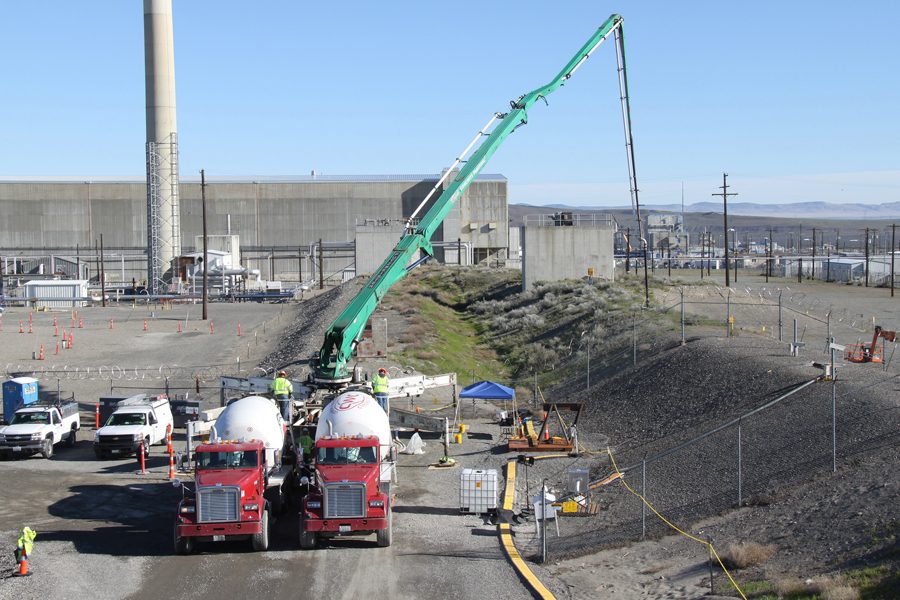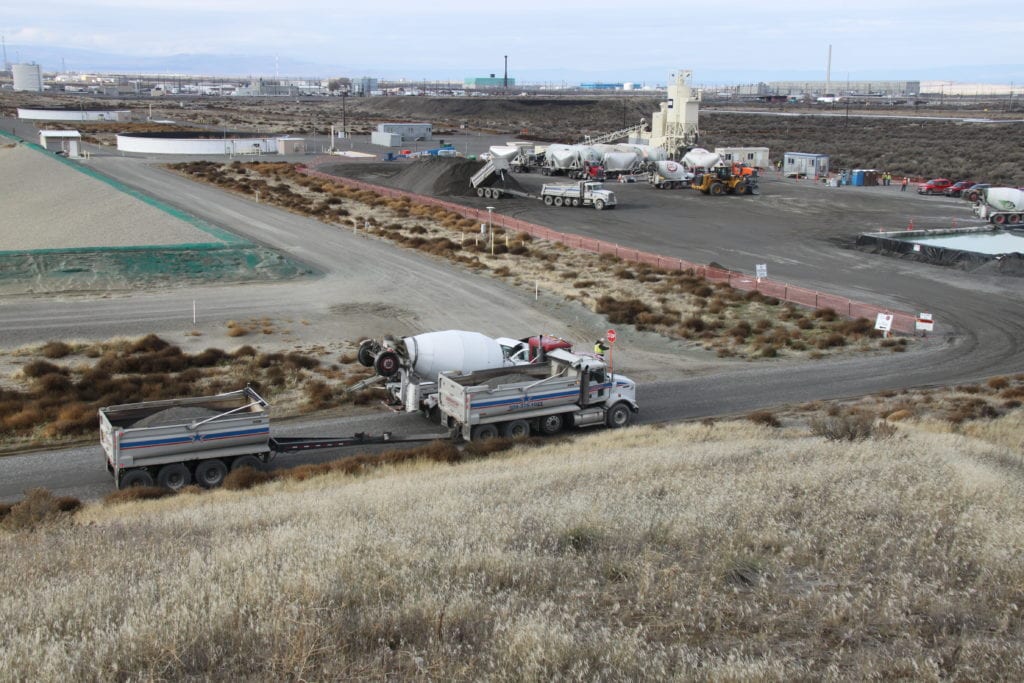
Home » PUREX tunnels stabilized after collapse
PUREX tunnels stabilized after collapse

May 16, 2019
Nearly two years after a 20-by-20 foot portion of the Plutonium Uranium Extraction Plant’s Tunnel 1 caved in, both it and its larger sibling, Tunnel 2, have been stabilized.
On May 9, 2017, U.S. Department of Energy workers discovered the 20-foot collapse of Tunnel 1, after noticing a background increase in radiation levels. Officials declared an emergency lockdown once they discovered the collapse, and no one was hurt. No radioactive materials were released in the collapse. The hole was filled immediately, and plans to stabilize the tunnels and investigate Tunnel 2 for sturdiness followed. The Washington state Department of Ecology issued an enforcement order on May 10, 2017, following the collapse.
The two-year unraveling of the collapse and subsequent grouting of not only Tunnel 1 but also Tunnel 2 helps paint a picture of just how tedious, toxic and urgent work at the country’s largest nuclear waste site can be.
The PUREX tunnels were initially used as rail car tunnels back when the Hanford Nuclear Plant was producing plutonium used in the country’s nuclear program during World War II and through the Cold War. The rail cars were used to store and transport failed equipment and chemical waste at the Plutonium Uranium Extraction plant, which an expert panel report that helped guide what should be done with Tunnel 2 described as “the workhorse of the nuclear materials production facilities.”
The tunnels were built at the end of the PUREX plant to push malfunctioning or failed equipment and materials out of the way. Tunnel 1 was constructed between 1954-56 with wood timbers. Tunnel 2 was constructed of steel and concrete in 1964.
When the plutonium production plant ceased operations, the rail cars were abandoned — potentially contaminated equipment and containers of waste included — inside the tunnels. Tunnel 1 holds eight rail cars; Tunnel 2 holds 28 rail cars. The initial intent was for the tunnels to connect to an extension entrance to another disposal facility, and plans for a third tunnel never came to fruition. Instead, rail cars full of items like failed “concentrators” or “miscellaneous jumpers in box and two tube bundles” were stored in Tunnel 1 as early as 1960 or scrubbers and vapor lines stored on rail cars in Tunnel 2 in 1971.
Following the May 2017 tunnel collapse, CH2M Hill began work to grout Tunnel 1, within a month after the Washington State Department of Ecology issued an enforcement order demanding immediate action. CH2M Hill and its subcontractors finished grouting the tunnel, stabilizing it by Nov. 1, 2017. In the meantime, the U.S. Department of Energy investigated Tunnel 2, fearing for its structural integrity after its sibling’s collapse. Officials concluded that although it was built a decade later, Tunnel 2 was also at risk for collapse. Both tunnels did not meet structural standards, an analysis found.
The race was on to secure Tunnel 2 before it met a similar fate to Tunnel 1. One CH2M Hill presentation explaining its plans said that “structural failure must be anticipated.” The Department of Energy convened an expert panel and solicited public comment about possible action plans for this tunnel, and the panel decided that grouting this tunnel was the best, most efficient option.
On April 29, 2019, grout work on Tunnel 2 finished, meaning both PUREX tunnels are now stabilized for the time being. Grouting, while not a permanent solution for containing toxic waste, is a sufficient temporary solution, and enables workers to go in later and dispose of the materials.
Ultimately, the expert panel believed that grouting left future work options open to the Department of Energy.
“…the panel concluded that stabilization with grout facilitates future options for disposition, whether those options involve in-situ disposal or removal of materials,” according to a September 2017 report.
Ultimately, the expert panel concluded that the Tunnel 1 collapse was likely due to the deteriorating wood used to construct it, and water loading from snow and rain. Weather is no small factor in determining the pace of work at the Hanford site. The project to grout Tunnel 2 had 23 days of weather delay after record snowfalls in southeastern Washington this year.
“We had a few delays—we had a pretty rough winter stretch in February and early March, with lots of snow that caught us by surprise,” said Dieter Bohrmann, communications specialist at CH2M Hill Plateau Remediation Co., the contractor on the PUREX project.
While finishing grouting means the tunnels are stabilized for now — future work remains to be determined.
“There could be further decisions down the road with what to do with it, but it’s stable now, it’s safe,” Bohrmann said.

(Courtesy CH2M Hill Plateau Remediation Co.)
Long term, the tunnels will ultimately need to be cleaned out since they contain radioactive waste and contaminated equipment, but Mark Heeter, public affairs specialist with the Department of Energy’s Richland Operations Office, said those decisions will be made in the future.
“The grout was designed to be able to be remediated or removed along with the equipment that’s in there, so while this stabilizes the tunnel, it does not represent a final decision on the disposition of the materials inside those tunnels,” he said.
In recent years, the PUREX tunnels have received much attention and prioritization at the site, especially following the collapse, but projects across the Hanford area are constantly being evaluated for prioritization. CH2M Hill, as a contractor of the Department of Energy, is reliant on the annual funding that flows to the agency through a budget approved by Congress every year. Currently, CH2M Hill is cleared and funded to wrap up their work on the PUREX project by Sept. 30, when the fiscal year ends.
Bohrmann said the final cleanup numbers of the grouting project on Tunnel 2 were impressive, with close to 40,000 cubic yards of grout filling the nearly 1,700 foot long Tunnel 2, completed in less than a year.
Grouting the PUREX tunnels is not the first time the method has been used at Hanford, Heeter said, adding that grouting is a good example of where the Department of Energy has continued to evolve as the agency learns how to best treat and dispose of waste. Grouting is a method used at other Department of Energy nuclear waste sites as well, like in South Carolina at the Savannah River plant as well as at the Waste Encapsulation and Storage Facility and U Plant at Hanford.
Local News Hanford
KEYWORDS may 2019




